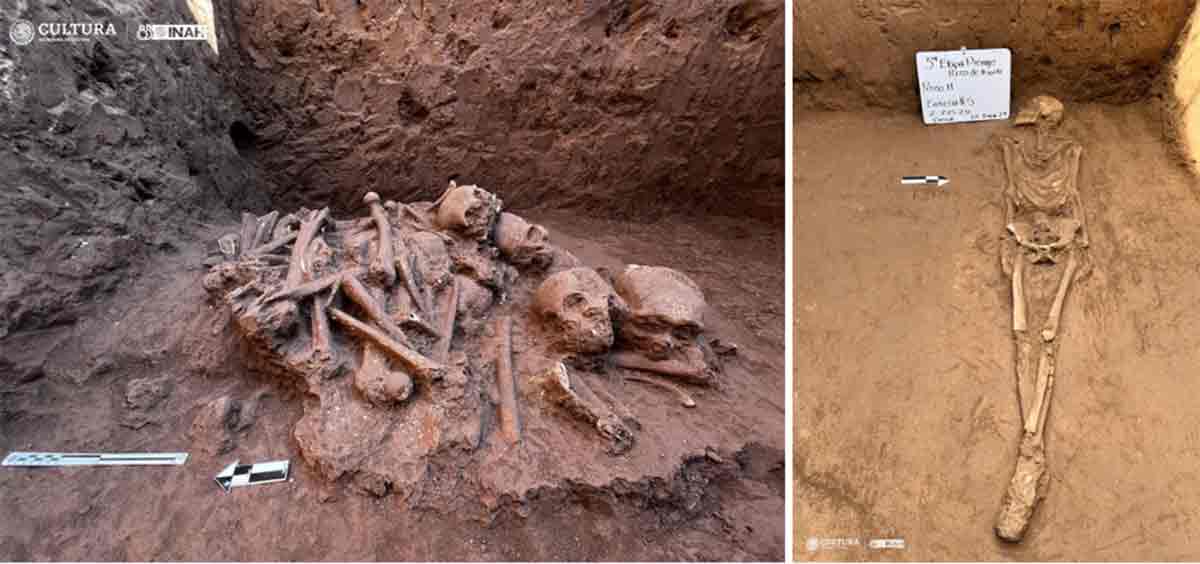Stacked Skulls and Bones Show Intriguing Pre-Hispanic Funerary System
Investigators have uncovered a burial ground from the pre-Hispanic era in today’s Mexico, which exhibits unique burial practices and how they were carried out in the region.
The discovery occurred in the town of Pozo de Ibarra, in Nayarit municipality, near the west coast where a sanitary sewage network construction project is being carried out. The archaeological rescue was carried out by personnel from the INAH Nayarit Center, to safeguard the heritage, in collaboration with the government of Nayarit, through the State Commission for Drinking Water and Sewage.
Not Quite Just a Pile of Bones
According to Claudia Servín Rosas, the field archaeologist in charge of rescue work, it is a burial system composed of a primary burial with the skeleton remaining anatomically intact, which is accompanied by a concentration of human bone remains deposited without anatomical relationship, but placed in a particular arrangement.
- Dinosaur in Mexico: New “Talking” Species Used Low Frequency Sounds
- 23,000-Year-Old Human Footprints Found In New Mexico Are Revolutionary

Claudia Servín Rosas, and another archaeologist from I NAH excavating the skeletal remains. (Claudia Servín Rosas/INAH)
The investigation identified that long bones, such as femurs, tibias, radii and ulnae, were carefully placed in a specific sector. Similarly, the skulls were intentionally grouped, some even stacked on top of each other, in another sector of the ossuary.
Controlled explorations allowed the investigators to recognize that the burial is part of a complex funerary system, since the arrangement of the bone remains was made at a single time, when the bones were already skeletonized.
This method of arrangement suggests the existence of specific ceremonial practices associated with death in pre-Hispanic times in the region. The discovery is possibly related to the Amapa cultural phase (500-800/850 AD), because ceramic vessels and anthropomorphic figurines from that period were also recovered.
- Post-Conquest Aztec Altar With A Burned Human Unearthed In Mexico City
- Skeleton Stalagmite Reveals Human Inhabitants in Mexico At Least 13,000 Years Ago

The excavated skeleton in situ at the site. (Claudia Servín Rosas/INAH)
During the field analysis, at least seven complete skulls were recorded, presumably belonging to male individuals of different ages, some of which present evidence of cranial modification, a cultural practice identified as part of the social dynamics related to Mesoamerican cultures. which involved alterations in the shape of the skull for aesthetic purposes and, possibly, as a form of social distinction.

The ossuary of stacked bones of the pre-Hispanic burial system. (Claudia Servín Rosas/INAH)
As part of the interpretations of the meaning of this find, it is suggested that perhaps it was part of the funerary rites that were carried out in the locally in the region, which could have been based on the burial of male members of the same family as part of a ritual to celebrate the founding of a settlement.
This archaeological find is exceptional, since there are no precedents for this type of burial in other nearby sites, and it enriches the understanding of funerary practices in the region. In addition, it encourages collaboration between the different INAH bodies for the protection, research, conservation and dissemination of heritage.
Since this discovery in Pozo de Ibarra, strategies have been implemented for the conservation of the remains, which favors their preservation. The work carried out so far reinforces the commitment to carry out more detailed and exhaustive studies regarding the worldview of the pre-Hispanic society that inhabited the territory that the town occupies today.
The discovery highlights the importance of the work carried out by the INAH in conjunction with state agencies for the exploration and preservation of the archaeological heritage of Nayarit. Although there is still no specific date, both parties are preparing and agreeing to continue the archaeological rescue to attend to the next stage of the work.
Top image: Left, stacked bones of pre-Hispanic burial system; Right, complete skeleton. Source: Claudia Servín Rosas/INAH
This article is a translated press release titled, “The INAH discovers pre-Hispanic funerary system in Nayarit” published by INAH, with light editing.

















